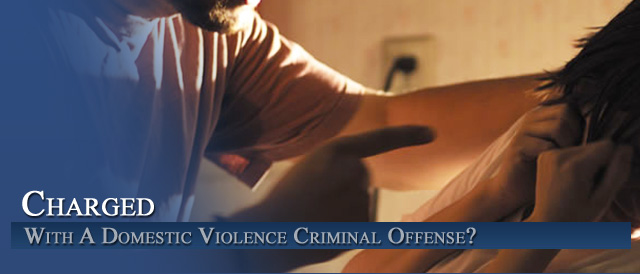




Colorado Criminal Law – Domestic Violence – How Colorado Courts Measure and to Predict Domestic Violence Threats – the Domestic Violence Risk and Needs Assessment (DVRNA)
The most recent edition of the Domestic Violence Risk and Needs Assessment (DVRNA) was drafted in 2010. This “test” permits approved providers of DV treatment in Colorado to measure the alleged threat of an individual who has been convicted of or pled to a domestic violence related charge.
Colorado, until recently, mandated a 36 week DV therapy program. The Colorado State Legislature changed the law to now require an open ended evaluation process and the tailoring of the mandated treatment program to the individual. The DVRNA is utilized to measure the risk of the individual and the requisite treatment that allegedly is intended to address and treat the risk.
The test was developed by the Colorado Domestic Violence Offender Management Board pursuant to the so called “Standards For Treatment With Court Ordered Domestic Violence Offenders.” It is promoted as – through the use of 14 domains of risk to be “highly predictive of future violence.”
Here is the way the DVRNA is Scored.. – It is instructive to understanding the MINDSET OF THE COURTS AND THE DA.
(DVRNA Scoring Manual) Domestic Violence Risk and Needs Assessment (DVRNA)
Domain Risk Items – (14 “Domains”)
Domain A: Prior domestic violence related incidents
Domain B: Drug or alcohol abuse
Domain C: Mental health issue
Domain D: Suicidal/homicidal
Domain E: Use and/or threatened use of weapons in current or past offense or access to firearms
Domain F: Criminal history ¡V non domestic violence
Domain G: Obsession with the victim
Domain H: Safety concerns
Domain I: Violence and/or threatened violence toward family members including child abuse
Domain J: Attitudes that support or condone spousal assault
Domain K: Prior completed or non-completed domestic violence treated
Domain L: Victim separated from offender within the previous six (6) months
Domain M: Unemployed
Domain N: Involvement with people who have pro-criminal influence
Overview and Administration and Introduction
The Domestic Violence Risk and Needs Assessment (DVRNA) was developed by the Treatment Review Committee (Committee) of the Colorado Domestic Violence Offender Management Board (DVOMB). The Domestic Violence Risk and Needs Assessment (DVRNA) is a risk assessment for adult domestic violence offenders 18 years and older. It is intended to be completed once all the evaluation data has been gathered.
This instrument was designed to identify risk factors that should be considered when working with domestic violence offenders in treatment. It is only intended to be used for offenders who have been arrested and are in the criminal justice system for a domestic violence offense. The risk factors that are empirically based on this instrument are predictive for offenders in the criminal justice system. It aids in determining appropriate level of treatment intensity. The DVRNA presents a framework within which to assess the risk of future intimate partner violence for domestic violence offenders in treatment. The DVRNA takes numerous risk factors that have been identified through empirical research as increasing the risk of violence or escalating its seriousness and consolidates these factors into a single measure, thus providing a method of determining the likelihood (probability) of ongoing or repeat violence.
Description
The DVRNA is composed of 14 domains of risk most highly predictive of future violence, which were selected based on an extensive literature review, the clinical experience of the Committee, and the knowledge from the criminal justice system participants. Many items concern an offender¡|s criminal history.
A few domains are dynamic in nature, such as current lifestyle stability factors. Risk factors are used as one measure to assist with initial treatment planning including the design of offender competencies, and ongoing treatment plan reviews.
The DVRNA is a risk assessment tool that assigns offenders a total score based on risk for repeated domestic violence. Thus, an offender may be placed into one of three categories ofintensity of treatment; low, moderate, or high. For example, any indication of a Significant Risk Factor would require initial treatment placement in the moderate level at a minimum, while an indication of a Critical Risk Factor would require initial treatment placement in the high intensity level.
Documentation of Information Sources
When completing the DVRNA for each domain, it is essential to identify the sources utilized to obtain the information. It is preferable to use official records (e.g., mental health, criminal justice reports), credible offender reports and written collateral reports for this documentation. The scoring of the instrument is intended to be transparent and sources of information must be available.
Domain Risk Items
A: Prior Domestic Violence Related Incidents (Any of the following are Significant Risk
Factors that indicate initial treatment in Level B except number 1, which is a Critical Risk Factor and indicates treatment in Level C.
This domain applies only to adult criminal history Do not include offenses committed as a juvenile
1. Prior domestic violence conviction
Critical Risk Factor that indicates initial treatment placement in Level C.
Include self reports of convictions
Includes deferred judgments, guilty pleas
Include convictions identified in criminal history as reported by probation or criminal justice report
2. Violation of an order of protection (documented)
Include civil or criminal protection orders
Include past or current orders
Include temporary protection orders
Include alcohol violations
3. Past or present civil domestic violence related protection orders against offender
Does not include criminal protection orders related to the arrest and conviction.
Do not include automatic orders related to marriage dissolution
Include temporary and permanent orders
4. Prior arrests for domestic violence
Include any arrest as an adult that was identified in the arrest as domestic violence
5. Prior domestic violence incidents not reported to criminal justice system
Include incidents reported by the victim only if the victim gives written permission to include this in the scoring of the DVRNA.
Include offender self report of incidents
Include any incident commencing after age 18
Include incidents involving any intimate partner after age 18
Include incidents reported in writing by collateral contacts or documented interview(s).
Domain B: Drug or Alcohol Abuse (Any of the following are Significant Risk Factors that indicate initial treatment in Level B).
Requires use of a Division of Behavioral Health approved screening or assessment instrument and/or self-report or recent illegal activity involving substance abuse with emphasis on the most recent 12 months.
No problem indicates that there is no alcohol or drug abuse or that alcohol or drugs do not interfere with the offender’s functioning.
1. Substance abuse/dependence within the previous 12 months
Refer to the DSM-IV-TR (or current version) for substance dependence or abuse criteria.
2. History of substance abuse treatment within the previous 12 months, or two or more prior drug or alcohol treatment episodes during adult lifetime.
Include any court-ordered or voluntary substance abuse treatment or counseling.
Include offender self-report.
3. Offender uses illegal drugs or illegal use of drugs
Colorado Revised Statutes Section 18-18-404(1) refers to unlawful use of a controlled substance V using any controlled substance, except when it is dispensed by or under the direction of a person licensed or authorized by law to prescribe, administer, or dispense such controlled substance for bona fide medial needs.
Illegal use of drugs includes the abuse of prescription medication; abuse of over-the-counter drugs; and or using illegal drugs such as cocaine, heroin, LSD, methamphetamine, etc.
Tobacco is not included
You may use offender self-report, police report, criminal justice record, and other witnesses.
Discussion point: For offenders that report the use of medical marijuana:
For the purposes of scoring this instrument:
If the Approved Provider has verified the offender has a Colorado approved medical marijuana certificate AND the court or supervising agent for the court is allowing the offender to use the medical marijuana while under court supervision, then DO NOT score this as an illegal use of a substance.
Note: This does not prohibit an Approved Provider from also determining as necessary whether the marijuana use is being abused by the offender. If approved assessment instruments and evaluation identify that the marijuana is being abused, than this is scored under number 1.
If the Approved Provider verifies that the offender does not have a Colorado approved medical marijuana certificate AND the court or supervising agent for the court is NOT allowing the offender to use the medical marijuana while under court supervision, then score this as illegal use of a substance.
Domain C: Mental Health Issue
(Any of the following are Significant Risk Factors that indicate initial treatment placement in Level B at a minimum).
Mental health concerns may be documented from offender self-report, from the diagnosis by a qualified Approved Provider, from medical records, or from a practitioner qualified to identify a disorder. If an Approved Provider is not qualified to assess the mental health of an offender, the offender may need to be referred to a qualified clinician.
1. Existing Axis I or II diagnosis excluding V codes
The V code section of the DSM-IV-TR deals with other conditions that may be a focus of clinical attention. V codes are not a diagnosis and therefore not scored.
Do not score a substance abuse/dependence if this has already been scored on Domain B
Drug or Alcohol Abuse.
2. Personality disorder with anger, impulsivity, or behavior instability (SARA, 2008)
This item should be ascertained based on past or current mental health evaluations. If an
Approved Provider is not qualified to assess personality disorders, he/she needs to refer to an Approved Provider who is qualified or another qualified clinician.
Refer to the DSM-IV-TR (or current version)
3. Severe psychopathology
Psychopathy is a risk for violent behavior. It is a criminal justice construct. It is not defined in the DSM-IV-TR, subsequently you cannot diagnose someone as a psychopath. However, the degree of someone¡|s psychopathy can be used as a risk factor (HARE
Psychopathy Checklist Revised-providers must be trained in the use of this tool).
4. Recent psychotic and/or manic symptoms (SARA, 2008)
Recent is defined as the previous 12 months
Psychotic symptoms may include (a) grossly disorganized or illogical speech, (b) delusions, (c) hallucinations, and (d) grossly bizarre behavior. Manic symptoms include (a) extreme euphoria or irritability, (b) grandiosity, (c) racing thought and pressured speech, and (d) motoric hyperactivity.
5. Psychological/psychiatric condition currently unmanaged
This condition needs to be diagnosed by a medical or health care clinician, by medical records, or by offender self-report.
6. Non-compliance with prescribed medications and mental health treatment
This information should be obtained from offender self-report or medical records.
7. An offender exhibits symptoms that indicate the need for a mental health evaluation
These symptoms may include such indicators as possible depression, psychosis, mania, and/or anxiety.
Domain D: Suicidal/homicidal
1. Serious homicidal or suicidal ideation/intent within the past year
Serious is defined in the SARA means that the ideation is experienced as persistent and intrusive or involves high lethality methods; or that the level of intent is moderate to high.
This is a Critical Risk Factor that indicates initial treatment in Level C.
2. Ideation within the past 12 months
The term suicidal/homicidal ideation generally refers to thoughts of committing homicide/suicide, including planning how it will be accomplished.
May be obtained from offender self-report or documented by other clinicians
3. Credible threats of death within the past 12 months
Credible means that the threats were perceived as credible by the victim (SARA, 2008)
4. Victim reports offender has made threats of harming/killing her
If the information is revealed by a discussion with the victim, protection of the victim is priority. It is imperative that the if the victim signs a release that allows this information to be utilized for scoring the DVRNA, she/he understands the ramifications of signing such a form, possible retaliation from an offender and has received safety planning assistance from the treatment victim advocate.
When a victim states that his/her information cannot be revealed beyond the Approved Provider, the Approved Provider and the victim advocate, without compromising victim confidentiality, may consult with probation and shall ascertain other potential ways to document or address victim concerns. For example: If the victim reports substance abuse by the offender, the Approved Provider may require random urinalysis, thus obtaining information without revealing victim information.
Domain E: Use and/or threatened use of weapons in current or past offense or access to firearms
This information can be documented utilizing offender self-report, reports from probation, collateral reports, or police reports.
Use and/or threatened use of weapons include the threat or actual use of any weapon that poses potential realistic physical harm to the victim¡|s life. Potentially deadly weapons may include firearms, knives, and objects used as clubs; or such objects as tools, phones, etc. The object should not be a body part (e.g., hands, feet, mouth).
1. Gun in the home in violation of a civil or criminal court order
This is a Critical Risk Factor that indicates initial treatment in Level C
2. Use and/or threatened use of weapons in current or past offense
This is a Critical Risk Factor that indicates initial treatment in Level C
This information may be obtained from the police report and/or victim statements. If the information is revealed by a discussion with the victim, protection of the victim is priority. It is imperative that the if the victim signs a release that allows this information to be utilized for scoring the DVRNA, she/he understands the ramifications of signing such a form, possible retaliation from an offender, and has received safety planning assistance from the treatment victim advocate.
3. Access to firearms
Includes personal ownership of a firearm or living in a household with a firearm Do not score if the offender does not have access to firearms ¡V for example if they are stored or locked elsewhere outside the home.
If a court order is allowing the offender to have a weapon, this is still scored because the offender has access to a weapon.
Domain F: Criminal history V non domestic violence (both reported and unreported to criminal justice system.
This information may be documented from probation reports, arrest records, or offender self report.
This domain applies only to adult criminal history
1. Offender was on community supervision at the time of the offense
This is a Critical Risk Factor that indicates initial treatment in Level C
Community supervision includes supervised probation, unsupervised (court monitored) probation, parole, private probation, community corrections, pre-trial release, bond, etc.
2. Offender has a prior arrest for assault, harassment, or menacing
If there have been two or more arrests, this is a Significant Risk Factor that indicates initial treatment in Level B at a minimum. Do not include a domestic violence enhanced crime
3. Prior non domestic violence convictions at any time during offender¡|s adult life
Include any municipal, misdemeanor, and felony convictions. Includes all convictions except traffic violations
NOTE: IF the offender was scored on Domain B 2 only for two or more prior drug or alcohol treatment episodes during his/her lifetime DO NOT also score any related previous DUIs here.
4. Past violation(s) of conditional release or community supervision
Conditional release includes probation, parole, bail, conditional discharge, suspended sentence, or any other occasion in which the offender is at liberty in the community under supervision or other requirements ordered by the court. Violation of a no contact order counts as violation of conditional release
5. Past assault of strangers, or acquaintances
Assault includes physical assault, sexual assault and any use of a weapon. There does not have to be an arrest to code this item. Document how the information was obtained
6. Animal cruelty/abuse
Includes threatening, abusing, or killing a family pet. There does not have to be an arrest to code this item. Document how the information was obtained
Domain G: Obsession with the victim (Current victim or current partner only)
1. Stalking or monitoring
Stalking , as defined by the National Center for Victims of Crime, Stalking Resource Center, is a pattern of repeated, unwanted attention, harassment, and contact. It is a course of conduct that can include:
Following or laying in wait for the victim
Repeated unwanted, intrusive, and frightening communications from the perpetrator by phone, mail, and/or e-mail
Damaging the victim’s property
Making direct or indirect threats to harm the victim, the victim’s children, relatives, friends, or pets
Repeatedly sending the victim unwanted gifts
Harassment through the Internet, known as cyberstalking, online stalking, or Internet stalking
Securing personal information about the victim by: accessing public records (land records, phone listings, driver or voter registration), using Internet search services, hiring private investigators, contacting friends, family, work, or neighbors, going through the victim’s garbage, following the victim, etc.
2. Obsessive jealousy with the potential for violence, violently and constantly jealous, or morbid jealousy.
Morbid jealousy describes a range of irrational thoughts and emotions, together with associated unacceptable or extreme behavior, in which the dominant theme is a preoccupation with a partner¡|s sexual unfaithfulness based on unfounded evidence.
Individuals may suffer from morbid jealousy even when their partner is being unfaithful, provided that the evidence that they cite for unfaithfulness is incorrect and the response to such evidence on the part of the accuser is excessive or irrational.
Morbidly jealous individuals interpret conclusive evidence of infidelity from irrelevant occurrences, refuse to change their beliefs even in the face of conflicting information, and tend to accuse the partner of infidelity with many others.
This domain could be scored with evidence of a protection order that is based on stalking or a violation of that type of protection order. A charge for stalking with the current victim would also result in a score on this item.
If the offender was scored for a civil protection order under Domain A.3 and the protection order is due to stalking, also score this Domain.
Domain H: Safety concerns
Information should not be used if it compromises victim safety and confidentiality and if the victim has not signed a written release of information specifically related to what information the victim is sharing. It is imperative that if the victim signs a release that allows this information to be utilized for scoring the DVRNA, she/he understands the ramifications of signing such a form, possible retaliation form an offender, and has received safety planning assistance from the treatment victim advocate. If the information is in the police report, the victim need not sign a release or give permission for this information to be used.
1. Victim perception of lack of safety/victim concerned for safety
2. Victim (female victim in heterosexual relationship) believes offender is capable of killing her
NOTE: Even though threats of death are only scored for male offender against female victim, the MTT shall consider threats of death by the offender toward the victim regardless of gender and over ride the findings of the DVRNA if necessary.
3. Offender controls most of victim¡|s daily activities
4. Offender tried to choke victim
Although the medical terminology is strangle, victims more readily identify with the word choke when reporting abuse.
5. Physical violence is increasing in severity
6. Victim forced to have sex when not wanted
7. Victim was pregnant at the time of the offense and offender knew this.
8. Victim is pregnant and offender has previously abused her during pregnancy.
Domain I: Violence and/or threatened violence toward family members including child abuse
This does not include criminal history. If there is criminal history related to this/these incident(s), score only on Domain F, number 3.
1. Current or past social services case as an adult where the offender was party to the action. Voluntary social services involvement is not scored. This item is intended to be open or past cases in social services.
2. Past assault of family members
Assault includes physical assault, sexual assault, and any use of a weapon.
Family members include biological and legal relatives (parents, step-parents, siblings, etc.), as well as children by previous or present intimate partners.
Excludes previous or present intimate partners.
Score even if there was no arrest conviction. May be obtained from credible offender self-report and written collateral reports.
3. Children were present during the offense (in the vicinity)
A yes response would include any children in the home or location of offense even if they were sleeping, or it was perceived that they could not hear or see the offense.
Include all children under of age of 18 regardless of their relationship to the victim and offender.
Domain J: Attitudes that support or condone spousal assault
Support or condone either implicitly or explicitly, by encouraging (a) patriarchy (male prerogative), (b) misogyny, and/or (c) the use of violence to resolve conflicts.
Multiple arrests for domestic violence do not implicitly or explicitly imply attitudes that support or condone spousal assault.
1. Explicitly endorses attitudes that support or condone intimate partner assault
Explicit endorsed attitudes can be identified because they are precisely and clearly expressed or readily observable, leaving nothing to implication. It is expressed in a clear and obvious way, leaving no doubt as to the intended meaning.
Examples include: offender calling the victim by derogatory names, stating that the victim/partner should obey the offender, lack of obedience is justification for abuse, stating that the victim is too stupid to handle money.
2. Appears to implicitly endorse attitudes that support of condone intimate partner assault.
Implicit endorsed attitudes are suggested or understood without being directly stated. To imply is to suggest rather than to state. An action or incident can imply an idea that would otherwise have to be stated.
Examples include: offender justifies behaviors that indicate the victim provoked him; such as she wouldn’t stop talking or she was drunk. Offender provides covert messages around his/her true beliefs. Offender may verbally say he/she would not abuse his/her partner, but he/she is controlling and abusive by the actions of his/her behaviors.
Domain K: Prior completed or non-completed domestic violence treatment
Treatment occurred at any time in the past and was not completed, regardless of reason.
This information may be obtained from an Approved Provider or credible offender self-reports and written collateral reports from the criminal justice system. Prior treatment that occurred at any time in the past regardless of the type of discharge received, whether successful, unsuccessful, or administrative. Include any court-ordered or voluntary domestic violence treatment or counseling.
Domain L: Victim separated from offender within the previous six (6) months
This refers to the risk of separation and is scored based on the victim separating from the offender within six months prior to the offense. Score this only when the victim has chosen to separate. This does not include the offender separating or a court order that requires they separate. Also score this item if the victim left and returned to the abuser.
It is a risk factor that can be reviewed at time of evaluation and calculated as the six (6) months previous to the evaluation.
Additionally, any time the victim initiates a separation from the offender this is a risk and needs to be scored and taken into consideration by the MTT. The MTT will determine on a case by case basis if the victim leaves during the offender’s treatment whether this will impact level of treatment or treatment planning.
Separation refers to physical separation.
Separation may include entering a shelter, moving out of the residence, moving in with friends, or eviction of the offender.
Domain M: Unemployed
Do not count employment that is criminal in nature (e.g. drug dealing).
Unemployed is defined as not working at time of offense or at any time during intake or treatment and does not include offenders on public assistance, homemakers, students, or retirees.
An offender that is unemployed and collecting unemployment is scored as unemployed.
Domain N: Involvement with people who have pro-criminal influence
In order to score one point in this domain, both of the following factors shall be present.
1. Some criminal acquaintances
The presence of some criminal acquaintances is associated with an opportunity for pro-criminal modeling, a concept that is considered a major risk factor
Explore the scope of criminal involvement of the individual¡|s network and to what degree it is an accepted norm.
Score if the individual associates with (or did associate with prior to incarceration) some individuals who are not close friends, but are known to have criminal records or are known to be involved in criminal activity.
Potential questions that can be asked: Of the friends you just mentioned (reiterate by name if possible) which ones have been in trouble with the law, as far as you are aware? For acquaintances or friends that have criminal records but are now clearly pro-social and stable, e.g., NA or AA sponsor with several years clean and sober, do not count these individuals as a pro-criminal influence
AND
2. Some criminal friends
Attachments to pro-criminal others is a well documented predictor of criminal behavior, with roots in both of the major explanatory theories in criminology: social control Inquire whether the offender’s friends are known to be involved in unlawful behavior.
Potential questions that can be utilized are: You’ve indicated ____ and ____ and ____ are friends of yours. What kind of experience have they had with criminal behavior?”
Explore the criminal orientation (to what degree they participate or support unlawful activities) of the individual’s friends. Score if the individual has friends (or did prior to incarceration) who are known to have criminal records or are known to be involved in criminal activity.
Friends are associates with whom one spends leisure time, whose opinions are valued, who provide help when in difficulty, etc.
Other Articles of Interest:
- Colorado Domestic Violence Cases – The Levels of Treatment A – B – C Explored – The Colorado Domestic Violence Offender Management Board Standards For Treatment With Court Ordered Domestic Violence Offenders
- Colorado Domestic Violence Cases – How Do I Get Off Of This Ride? Discharge Standards, Risk Categories and the Completion of Court Ordered Mandated Treatment – Part I
- How Colorado Criminal Offenders Are Sentenced – Judges Assess Risk
- Colorado Criminal Domestic Violence Laws – Couple’s or Martial Counseling NOT Allowed in Domestic Violence Treatment Programs
- Colorado Criminal Domestic Violence Cases – The Role of Mental Health Assessment in Colorado Domestic Violence Cases












